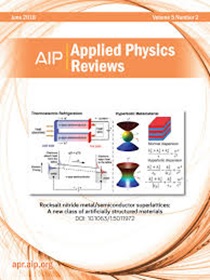Microcavity-based parallel measurements of optical power and wavelength
IF 11.6
1区 物理与天体物理
Q1 PHYSICS, APPLIED
引用次数: 0
Abstract
Accurate determination of light power and wavelength is fundamental to nearly all optical and laser applications. However, simultaneous and precise measurements of these two parameters remain a critical challenge due to intrinsic cross-sensitivity in conventional devices. Here, we propose and demonstrate a dual-parameter decoupling strategy based on photothermal whispering gallery mode (WGM) microcavities, enabling parallel measurements of both optical power and wavelength without cross-sensitivity. Optical absorption of the pump light by the composite microcavity produces increased temperatures that are proportional to the pump power and wavelength of the light, resulting in a wavelength shift in the WGM resonance of the microcavity. We demonstrate a record-high photothermal tuning sensitivity of ∼−4 nm/mW and an ultralow detection limit of thermal power down to 4 μW, both of which surpass all previous schemes by more than an order of magnitude. With a linear response to the pump wavelength, the designed microcavity allows for near-infrared wavelength measurement over a broad bandwidth from 780 to 1064 nm. Importantly, by introducing the decoupling strategy that employs spectral changes of two microcavities with asymmetric responses, we demonstrate parallel measurements of both optical power and wavelength with high accuracy. As the first proof-of-principle demonstration of a single optical power–wavelength measurer using optical microcavities, our work could advance various applications relying on miniaturized and precise optical metrology devices.基于微腔的光功率和波长平行测量
光功率和波长的精确测定是几乎所有光学和激光应用的基础。然而,由于传统设备固有的交叉灵敏度,同时精确测量这两个参数仍然是一个关键挑战。在这里,我们提出并演示了一种基于光热低语通道模式(WGM)微腔的双参数解耦策略,实现了光功率和波长的并行测量,而没有交叉灵敏度。复合微腔对泵浦光的光吸收产生与泵浦功率和光的波长成正比的温度升高,导致微腔WGM共振的波长移位。我们展示了创纪录的高光热调谐灵敏度(~ - 4 nm/mW)和超低的热功率检测极限(低至4 μW),两者都超过了所有以前的方案一个数量级以上。设计的微腔对泵浦波长具有线性响应,可以在780至1064 nm的宽带宽范围内进行近红外波长测量。重要的是,通过引入利用具有非对称响应的两个微腔的光谱变化的解耦策略,我们证明了光功率和波长的高精度并行测量。作为首个使用光学微腔的单光功率波长测量仪的原理验证,我们的工作可以推动依赖于小型化和精密光学测量设备的各种应用。
本文章由计算机程序翻译,如有差异,请以英文原文为准。
求助全文
约1分钟内获得全文
求助全文
来源期刊

Applied physics reviews
PHYSICS, APPLIED-
CiteScore
22.50
自引率
2.00%
发文量
113
审稿时长
2 months
期刊介绍:
Applied Physics Reviews (APR) is a journal featuring articles on critical topics in experimental or theoretical research in applied physics and applications of physics to other scientific and engineering branches. The publication includes two main types of articles:
Original Research: These articles report on high-quality, novel research studies that are of significant interest to the applied physics community.
Reviews: Review articles in APR can either be authoritative and comprehensive assessments of established areas of applied physics or short, timely reviews of recent advances in established fields or emerging areas of applied physics.
 求助内容:
求助内容: 应助结果提醒方式:
应助结果提醒方式:


